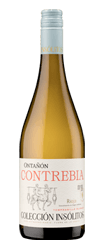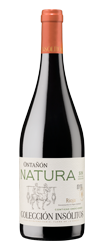Insólitos collection
Adventurers
Plinio El Viejo
Organic
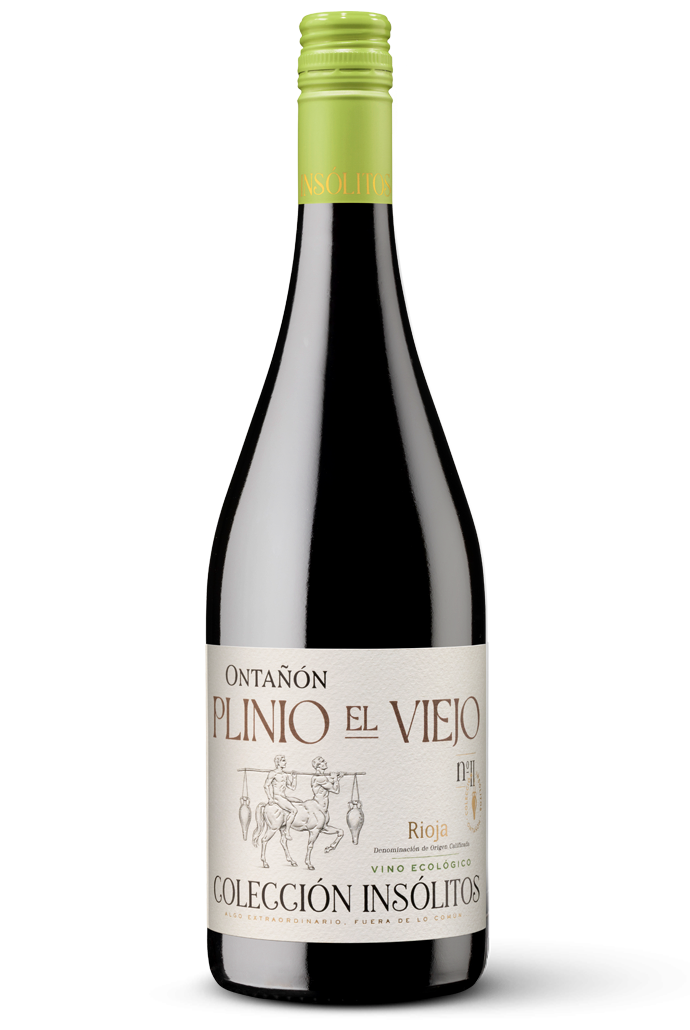
No perfume can better the aroma of its
vines

Plinio El Viejo.
In his monumental work, Natural History, Pliny places special emphasis on the world of wine and vine growing techniques.
But beyond his death, Pliny’s Natural History is regarded as the first great encyclopaedic collection of the Ancient World and it also places special emphasis on the world of wine and vine growing. Pliny studied philosophy and law in Rome, before embarking on a military career in which he reached high ranks under the Emperor Titus. He was governor of various Roman provinces and finally admiral of the Imperial Fleet in the Tyrrhenean Sea.
In the 37 volumes which make up his Natural History, Pliny gives a general overview of all the knowledge of the age, including fields such as geography, zoology, botany, metallurgy, pharmacology and even cosmology, among many others. Volume 14 is exclusively dedicated to wine; volume 17 contains descriptions of the techniques of viticulture of his times and at the beginning of volume 23 there are various comments about the curative powers of wine. What is certain is that no other author of Antiquity dealt with winemaking and vine growing so thoroughly.
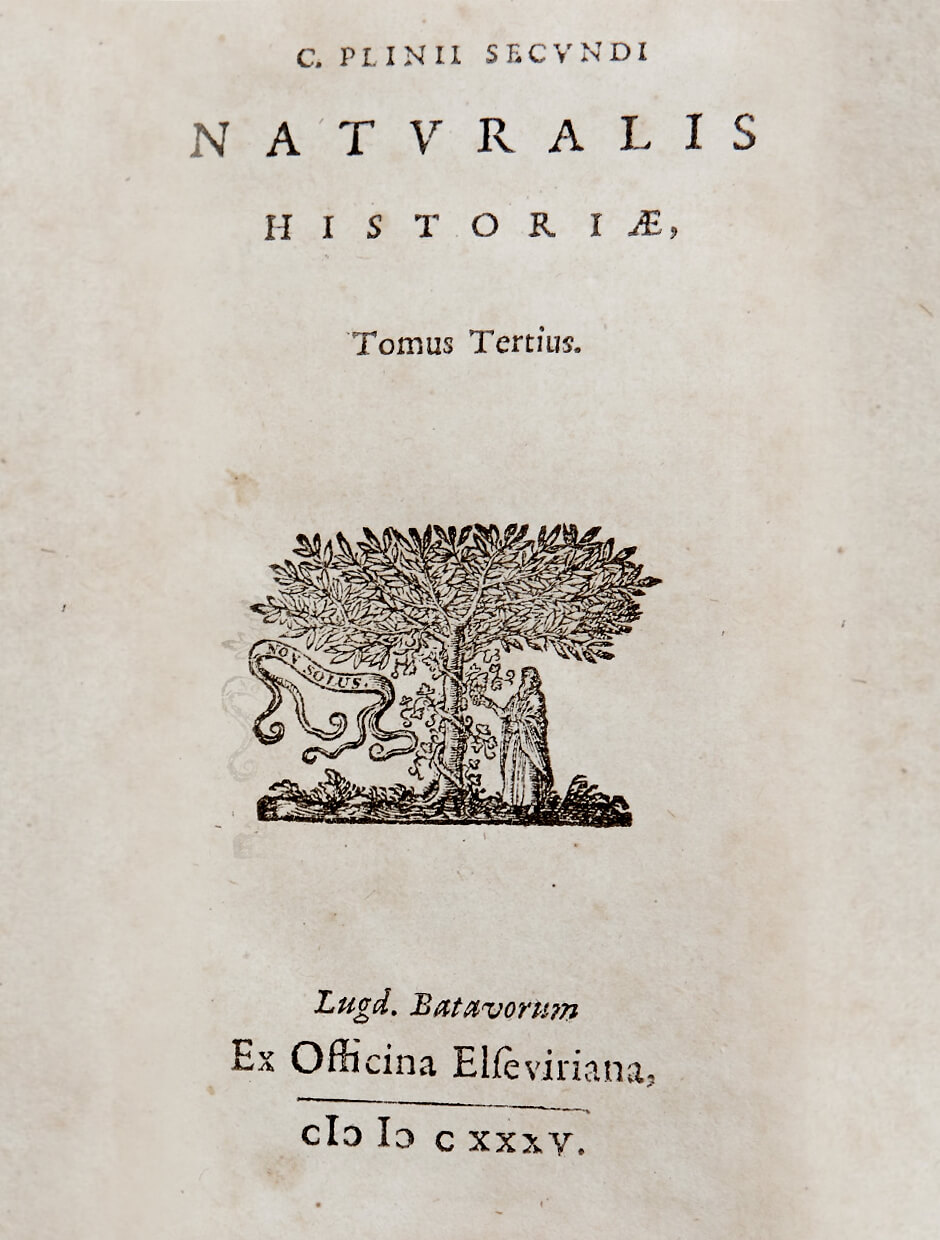
Cover of “Natural History” by Pliny the Elder.
Plinio
The territory and soil determine the quality of the wine
Pliny reached the conclusion that the territory and the soil determine the quality of the wine and mentioned such advanced techniques as sulphuring or using wooden vessels for storing wine.
Pliny recounted that the Roman legionnaires carried vine canes with their campaign equipment and would progressively plant vines in the conquered lands. His descriptions are astounding: in the vineyards of Aminea (Greece) there are “five species. The smallest have the smallest berries, have better flowering, and withstand the rain and bad weather. That is not the case with the largest, which attached to the trees suffer less than when yoked to another vine”. He also knew and described wines from other territories not from the Italian Peninsula, especially those from the Iberian Peninsula: “The Spanish distinguish two species, one with an oblong berry and the other elongated, and it is the last vine to be harvested. The sweeter the coccoloba (sea grape) the better. The one with an astringent taste becomes softer with age, and the sweet one becomes astringent with time”.
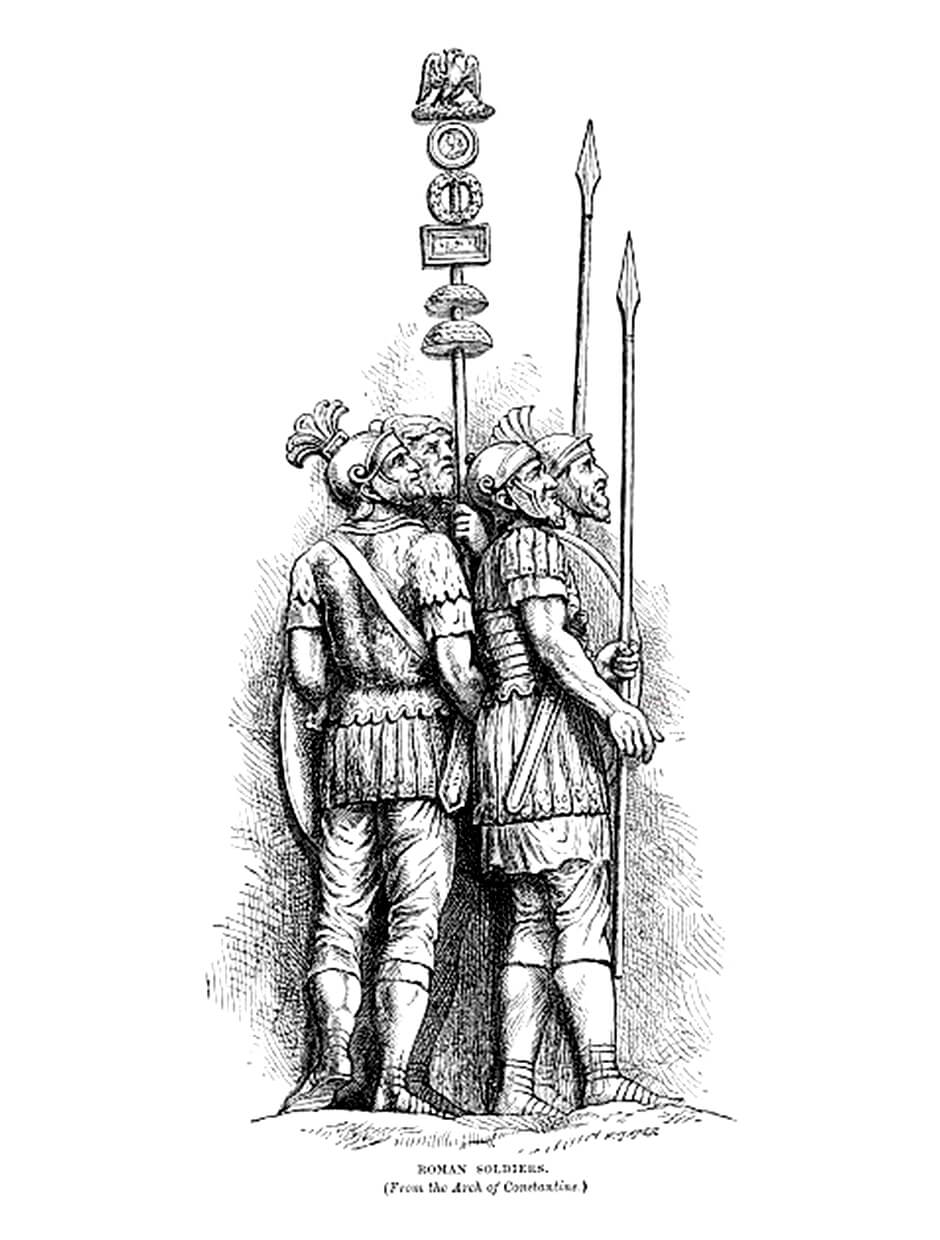
Roman legionaries carried vine rods in their campaign gear.
In another of his reflections, Pliny states that the vines need to be pruned every year and that all their force goes to the branches or go down to its shoots, and from there, and only thanks to its sap, it spreads in different ways, depending on the climate conditions or the properties of the soil.
Gaius Plinius is one of the great masters of antiquity and together with Varrón and Columela, one of the great students of historic viticulture methods. For the Roman world, agriculture and stock breeding were basic economic activities and the authorities made a great effort from very early on to provide their peasants with both theoretical and practical knowledge on these matters.
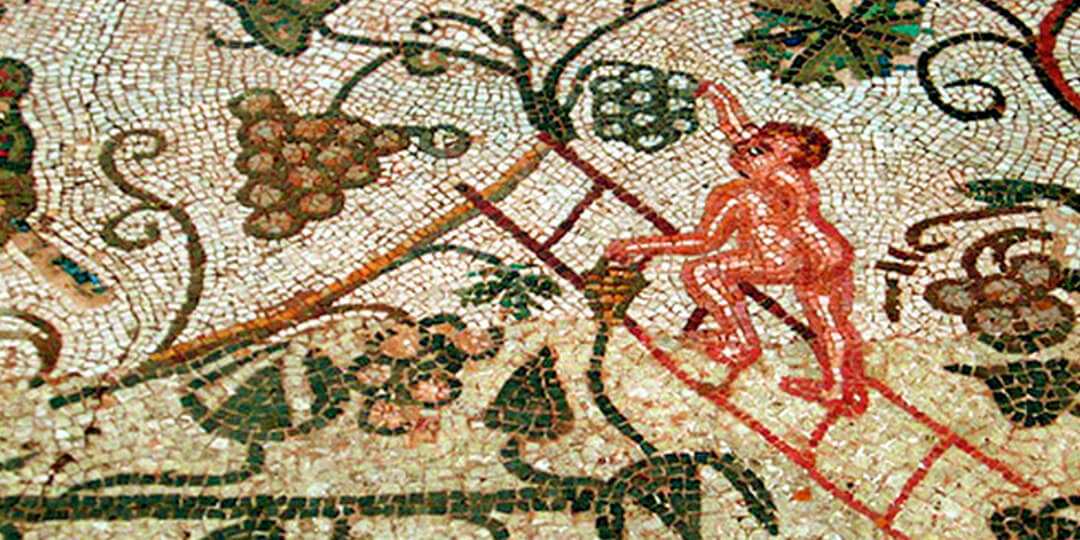
Roman mosaic from Mérida depicting the grape harvest.
Pliny as an inspiration
And who better to pay homage to our most virgin territory and to our wine from the organic vineyards of the Ontañón Familia. Pliny as an inspiration, as a search for the historical forerunners of wine as a fundamental fact of our culture, in our agriculture… Culture and agriculture, two words which come from the same root. Cultivo (crop in Spanish) comes from the Latin cultivus and means “related to the result of working and caring for the land to produce plants”.
A philosophy of life and wine
Rubén Pérez Cuevas, oenologist at Ontañón, explains that an organic wine is not a challenge, it is a philosophy, a way of acting which we apply to all the ways of producing, treating the vines, looking after the wine and bottling it with the maximum respect for nature, living alongside it in every possible aspect. “It is a contagious philosophy which affects all the processes of production with each and every one of its steps and thoughts. It is a formula which has as its goal to make the world in which we live much more rational and pleasant. And wine is an essential part of our way of understanding life”.
The vital key to our Plinio Ontañón Ecológico coincides with one of the pillars on which the philosophy of our bodega is based: passion for the vineyard. For us, Rubén stresses, “it is a mandatory principle to make a wine in which respect and love of nature is represented, the mother of our product and essence of the enthusiasm which we feel to do things better every day, representing as faithfully as possible the most intimate profiles of the characteristics of our vineyards, their soils, the territory in which they are located and the cycle of each year”.
Tempranillo
For our Plinio Ontañón Ecológico we have chosen to make it from a tempranillo grape variety. One of the reasons is that this variety – autochthonous to Rioja -, gives us marvellous touches of dark fruit and a very interesting acidity for its short time spent in the cask. It is the Rioja variety par excellence, the basis of its great red wines and one of the most highly regarded grapes in the world. It occupies 75% of the crop area of Rioja and according to studies of its DNA, conducted by the Instituto de Ciencias de la Vid y del Vino (ICVV) and the Instituto Madrileño de Investigación de Desarrollo Rural, Agrario y Alimentario (IMIDRA), it has been established that its origin was a cross between the albillo mayor white grape variety (turruntés), originally from Castilla-León and described by Alonso de Herrera in the year 1513, and the red benedicto grape from Aragón, described by Nicolás García de los Salmones in 1914 and which these days is on the verge of extinction. The first mention that exists of the cultivation of tempranillo in Rioja is by Valcárcel in his book Agricultura General (1791), in a work in which he cites tempranillo in Rioja together with varieties such as garnacha, mazuelo and barbés (possibly what is today known as graciano). This is what he says: ‘It is almost the same quality as the barbés, except that the skins are tougher, the cane is strong, moving in search of height, and it is harvested fifteen days earlier than the garnacha and mazuelo, and it makes a fairly strong wine’.
The production of Ontañón Plinio El Viejo
Harvesting by night
Ontañón Ecológico is a very special wine and all the aspects of its production are conducted with great care. Harvesting takes place at night to guarantee that the grapes are cool when they enter the winery so as to preserve all the tempranillo fruit aromas. The reception of the grapes comes from our organic vineyards and is performed separately on specific days set aside for their harvesting to ensure there can be absolutely no cross contamination with other grapes which are vatted in the traditional way.
The start of the fermentation process follows the “pie de cuba” method
We take a vat in which fermentation has already begun, extract part of the must and transfer it to a vat in which the new fermentation is going to begin. The yeasts, which are already active and in a process of multiplication, help the new fermentation to start more quickly.
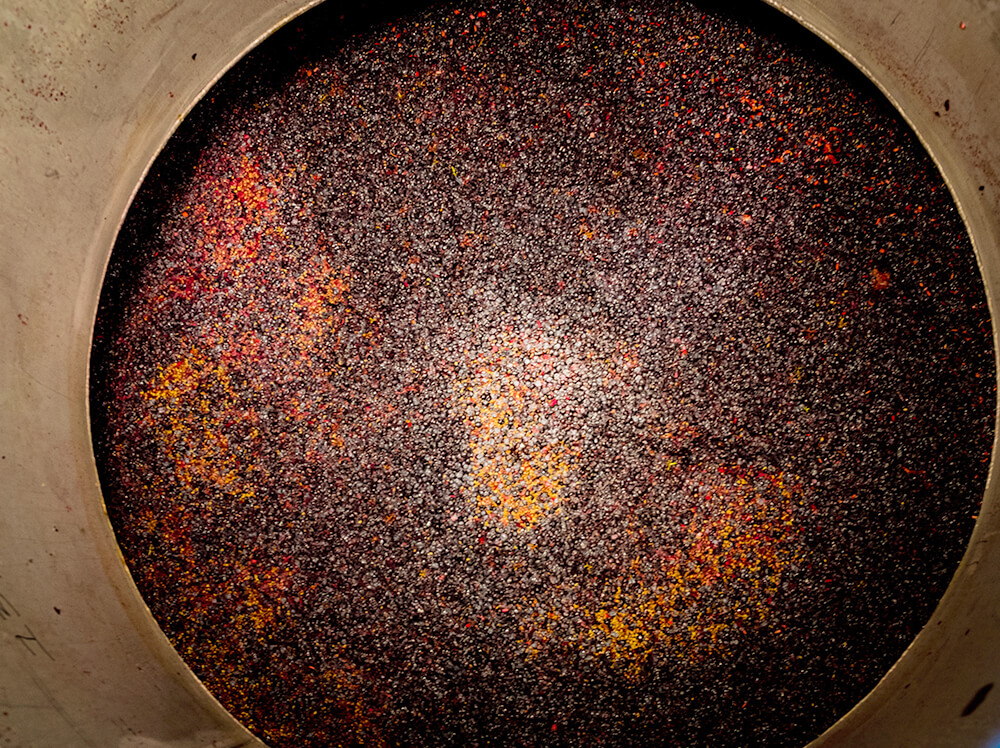
An image of the hat inside the tank.
Fermentation
We lower the temperature of the cake (the solid and liquid part) to leave it in cold maceration for around three days. What we are looking for here is the natural extraction of the anthocyanins, which we achieve in the aqueous phase of the wine in order to obtain the characteristic violet colour. After these three days of very gentle maceration, we release the temperature control so that fermentation can begin. The yeasts are those from the vineyard, which helps to reaffirm the personality of the berries thanks to their origin. One of the keys of this wine is that when pumping over, from a density of and to 1030, we use a system known as ‘Osiris’, in which the movement of the cap is achieved using noble gases. We create large air bags inside the tank with a set pressure so that these will lift the cap and turn it over. In this way we manage to integrate the grapes within the must without forcing them and in a very even way. We achieve greater and more complete extraction. When the must reaches a density of 1010, we separate the solid part from the liquid. With this system we are able to preserve all the grapes’ primary aromas: blackcurrants, blackberries, plums and violets, as well as the aromas of scrubland which are so typical in our territory.
Post-fermentative maceration
We perform post-fermentative maceration depending on the conditions of each vintage, although as a general rule it does happen, as we can extract the characteristics of the grapes while the wine is in contact with them; once we devat there is no going back, so we must always try to extract the maximum and normally the wine will remain in contact with the skins for another six to ten days. It is then devatted and malolactic fermentation takes place, which serves to polymerise the colour and to obtain a good part of the secondary aromas which are offered by its characteristic lactic aromas. Afterwards we leave the wine in repose for four months in vats so that it can fine itself naturally.
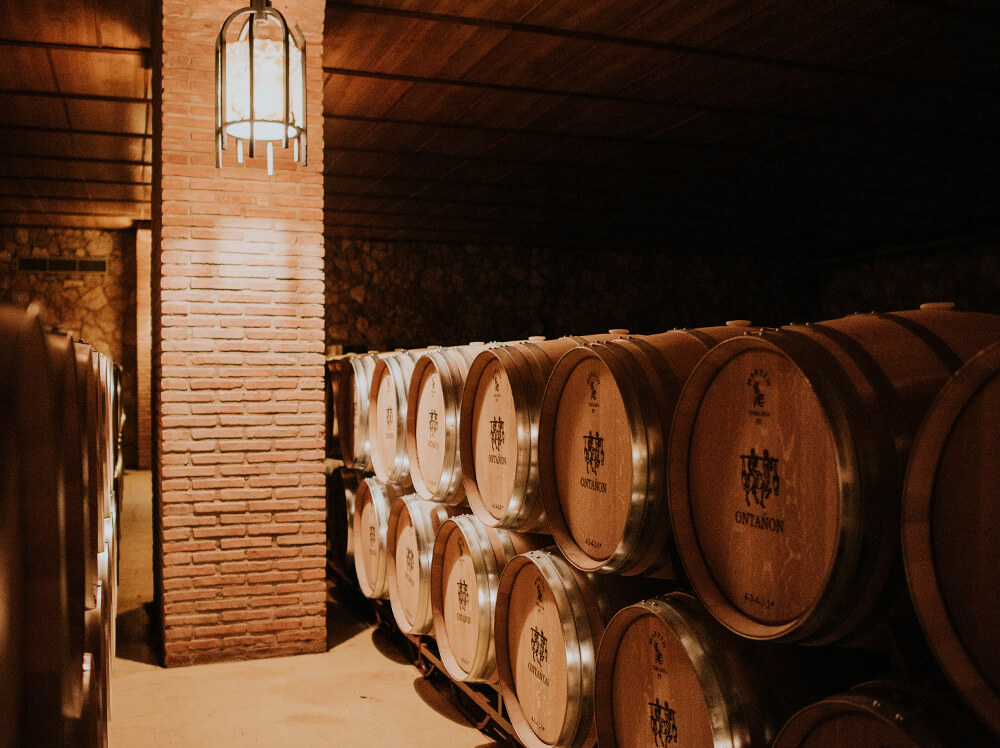
Ontañón barrel hall.
Four to six months in the cask
One of the features of this wine is its brief time in the cask (four to six months), which helps to heighten its fruit and floral aromas. The barrels have only contained organic wine, so there can be no kind of cross contamination from other wines, and are either new of used for two or three wines. The staves are a mixture of French and American oak and the top and bottom are of French oak. What we are looking for is micro oxygenation which enables the wine to open up, the aroma precursor molecules bond together and can be more sharply appreciated. It will also give us a small quality of tertiary aromas which are so good for the tempranillo and which is a great, genuine feature of Rioja wines.
And rounding off in the bottle
This is the phase in which all the moments that the wine has experienced during its production and the contributions made at each stage come together to achieve what in winemaking jargon we call “rounding”. The wine blends together, becomes balanced and the aromas, smells and flavours are refined in a reductive atmosphere which helps it to reach maturity.
Vegan and vegetarian
Respect for the vine is a fundamental point of the philosophy of Bodegas Ontañón and the fundamental example of this idea is our Ontañón organic. And because of the features of its production process it is especially suitable for vegans and vegetarians.
Viticulture
The grapes from which this wine is made come from one of our bodega’s most special vineyards: Andañal, a plot located at over 720 metres on the slopes of the Sierra de Yerga in the Quel district, more specifically, in the foothills of Monte Gatún. These vines, planted at different times in the years 1995, 2012 and 2016, are certified as organic and have a sandy loam textured soil (16.9% silts, 73.1% sand, 10% clay). Its height means that ripening is very slow and absolutely perfect for the tempranillo to show off its best notes of finesse, expression and subtlety.
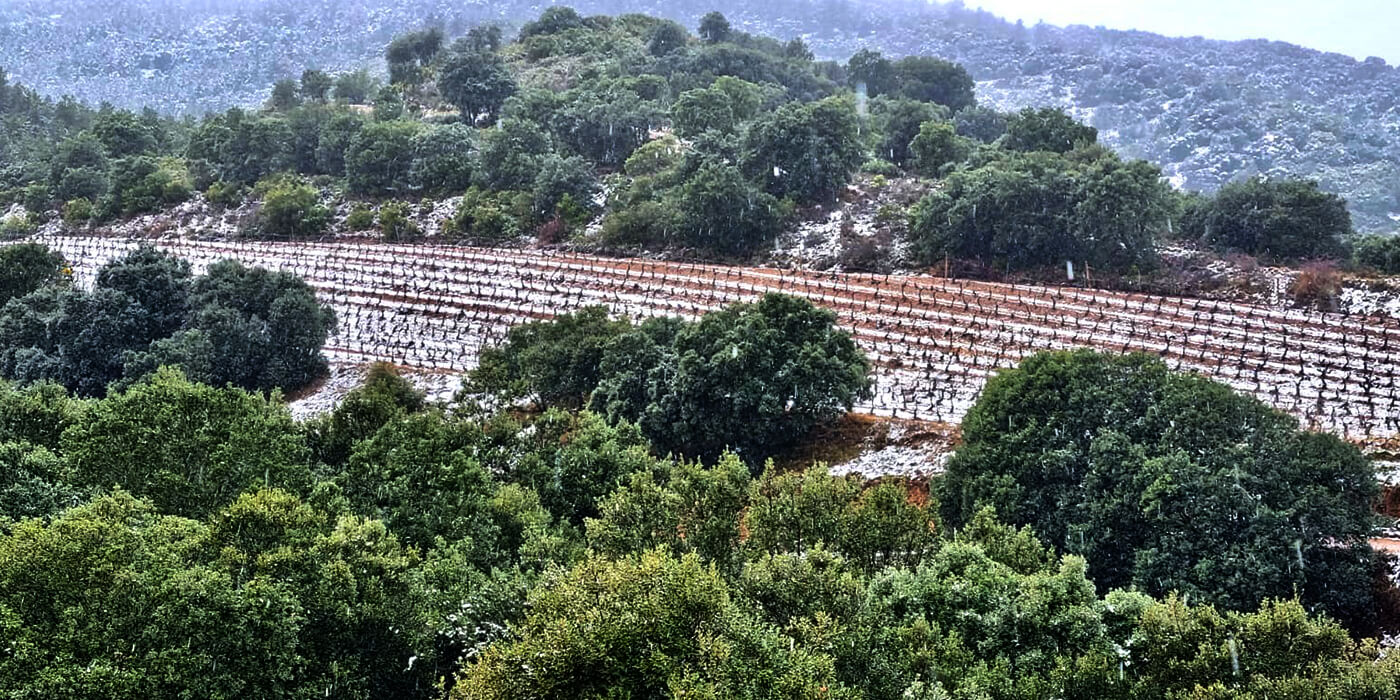
Snowfall in the Andañal vineyard, in the Sierra de Yerga.
Tasting
Cherry-red nuances and purple rim.
Complex on the nose, with a mingling of notes of ripe fruit, such as blackberries and blackcurrants, and toasted, spicy and mineral nuances from the ageing in high quality oak.
Elegant palate with a perfect balance between acidity and tannins, with hints of
minerality.
13,5% Alcohol by Vol.
Downloads
Tasting Notes 2021
· PDF ·
Image Bottle
· JPG ·
Label
· PDF ·


